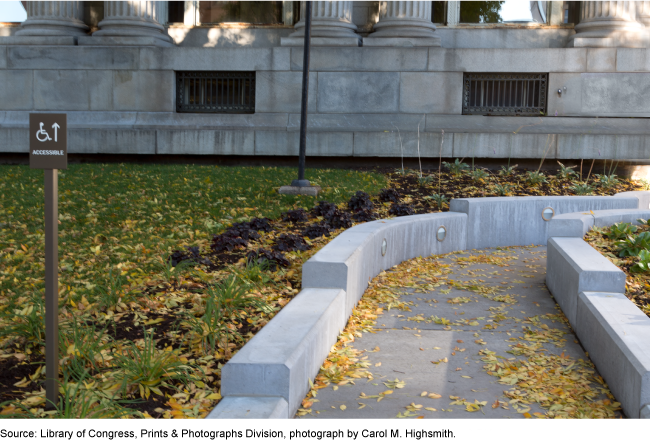U.S. Access Board: Interagency Efforts to Promote Accessibility for People with Disabilities Generally Followed Leading Collaboration Practices
Fast Facts
The U.S. Access Board promotes accessibility for people with disabilities by developing guidelines, providing technical assistance, and enforcing accessibility requirements at federal facilities.
The Access Board collaborates with other federal agencies on many of these activities. For example, it works with agencies to investigate and address public complaints about inaccessibility at agencies' facilities.
We found that the Access Board generally followed our list of leading practices for effective collaboration—such as having clear roles and responsibilities.
Wheelchair ramp at Minneapolis Federal Building, Minneapolis, Minnesota

Highlights
What GAO Found
The U.S. Access Board, which works to promote accessibility for people with disabilities, has collaborated with federal agencies to carry out the three key areas of its mission: developing accessibility guidelines, providing related technical assistance and training, and enforcing certain accessibility requirements applicable to federal facilities. For example, in updating accessibility guidelines, such as on medical equipment, it collaborated with federal agency members on its governing board to obtain input and approval. The Access Board also collaborated with relevant agencies when providing technical assistance, such as on designing accessible electric vehicle charging stations. Additionally, the Access Board uses a collaborative approach with federal agencies when investigating public complaints about inaccessibility at federal facilities.
The Access Board and selected agencies generally followed leading collaboration practices for the three selected efforts that GAO reviewed. In the few instances where the agencies had not fully followed a leading practice, GAO found that the agencies either were taking action to more fully implement the practice (e.g., recruiting additional participants) or used other ways to communicate and agree on interagency plans (in lieu of written agreements). (See example below.)
Examples of Actions Taken by the U.S. Access Board and the Department of Transportation on Developing Public Rights-of-Way Accessibility Guidelines, Organized by Leading Collaboration Practices
|
Practice |
Examples of Actions |
|---|---|
|
Outcomes and Accountability |
Agencies shared goals of drafting guidelines that reflected the expertise of relevant agencies and of facilitating subsequent steps in the rulemaking process. Officials tracked and communicated progress at board meetings. |
|
Bridging Organizational Cultures |
Agencies relied on long-term working relationships and common terminology to bridge their distinct cultures and missions. |
|
Leadership; Clarity of Roles, Responsibilities |
As this collaborative effort focused on developing Access Board's guidelines, officials from both agencies were clear on roles and responsibilities, including Access Board's leadership role. |
|
Participants |
Relevant staff attended meetings regularly and brought their expertise and institutional knowledge to develop the guidelines. |
|
Resources |
Both agencies contributed staff time and expertise. The Access Board primarily funded necessary activities, such as a cost benefit analysis, given its leadership role. |
|
Written Guidance and Agreements |
The Access Board did not have formal documents outlining detailed plans for the collaborative effort with the Department of Transportation, but plans were communicated in frequent meetings and emails. Further, additional formal guidance or agreements were not needed, given that the collaborative effort ended in March 2023. |
Source: GAO analysis of interviews with agency officials and related documents. | GAO-23-105948
Why GAO Did This Study
The U.S. Access Board is a small federal agency ($9.8 million operating budget in fiscal year 2022) that promotes accessibility for people with disabilities. Because the Access Board is structured as a coordinating body with a governing board that includes federal agency representatives, interagency collaboration is a key feature of its work. GAO was asked to examine the Access Board's interagency collaboration in achieving its mission and goals.
This report examines (1) the ways the Access Board collaborates with federal agencies to accomplish its mission and goals and (2) the extent to which the Access Board's collaboration with federal agencies on selected efforts aligns with leading collaboration practices.
GAO analyzed Access Board documents such as its performance and accountability reports from 2017 to 2022; conducted structured interviews with the Access Board and three other federal agencies (Department of Transportation, General Services Administration, and U.S. Postal Service), and reviewed related agency documents and information. The three selected collaborative efforts varied across the Access Board's key work areas, access mode (e.g., digital or physical), agencies involved, and the Access Board's role. GAO assessed the efforts against leading collaboration practices previously identified by GAO.
For more information, contact Elizabeth Curda at (202) 512-7215 or curdae@gao.gov.
